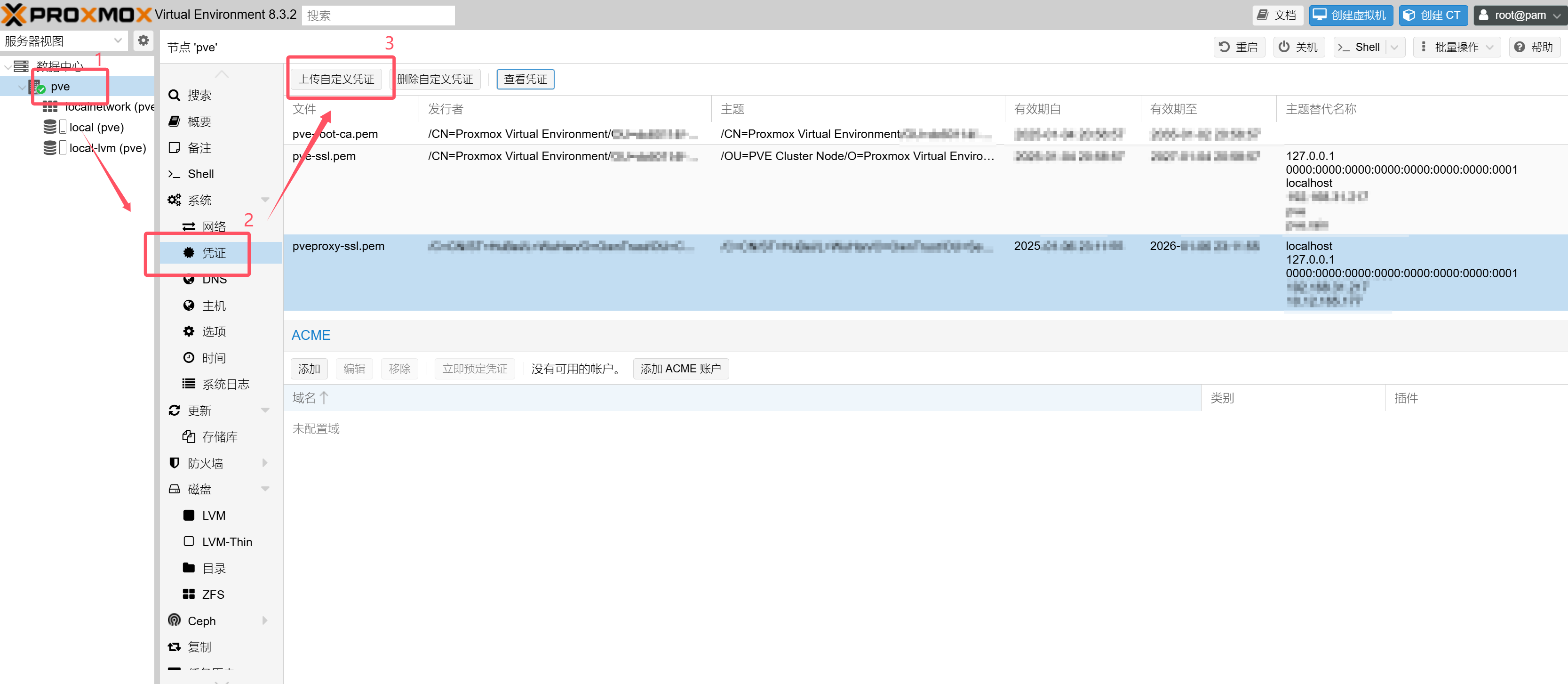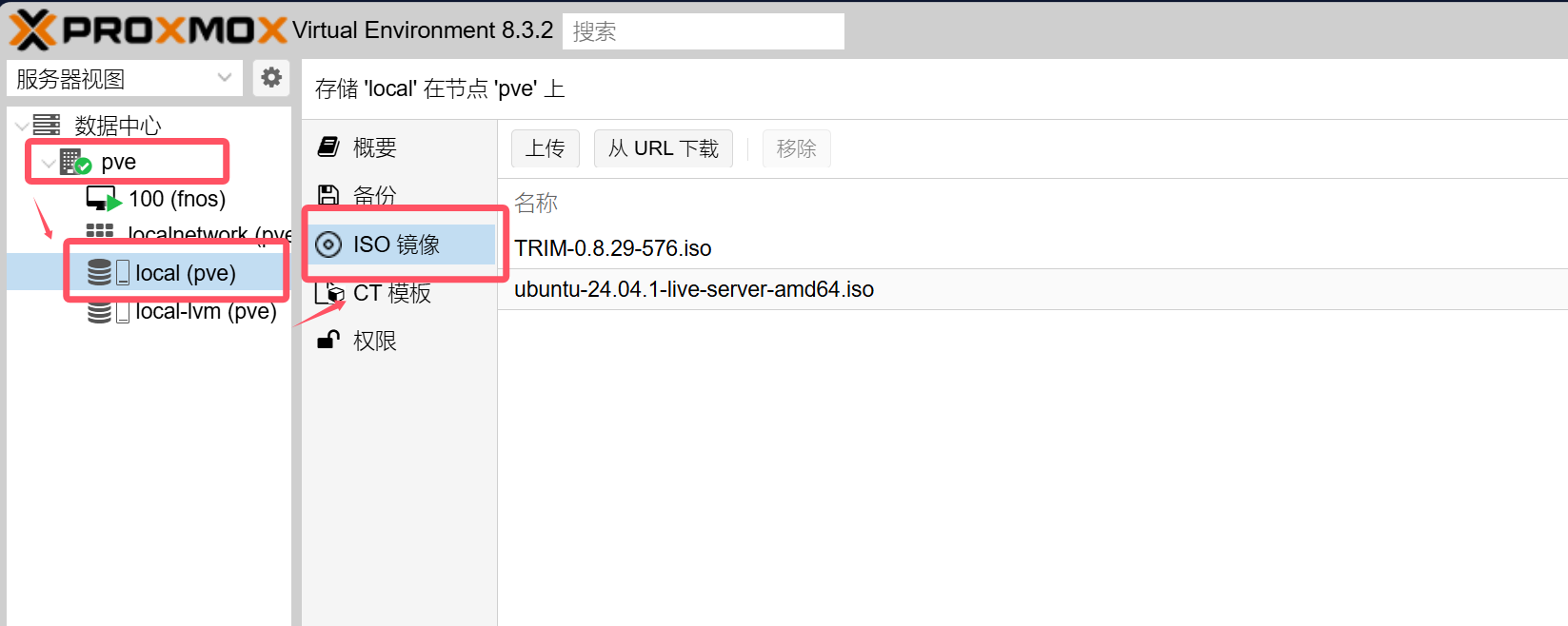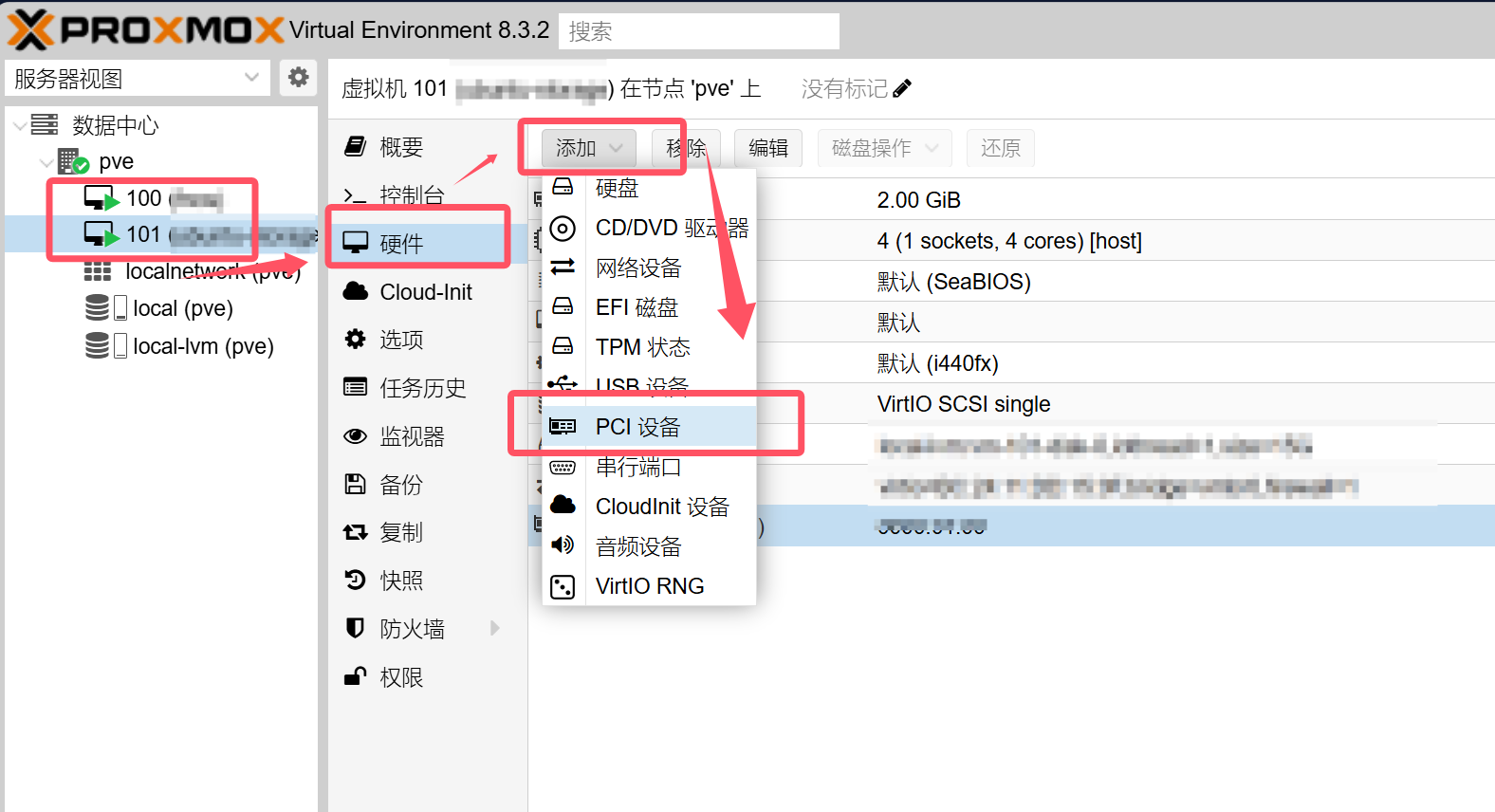pve安装及配置
咸鱼捡垃圾碰巧捡了个华硕B250M主板+Intel i5 7500,碰巧捡了个拓扑龙的8盘位机箱,碰巧捡了个pcie转sata卡,碰巧捡了个益恒250W flex电源,碰巧捡了好几块机械硬盘。折腾一下pve。
主板+CPU+内存条:¥350
机箱:280+54-20-90+118=¥342
PCIE扩展卡:¥35
电源:¥283
Total:¥1010
还没算硬盘,多少有点贵了。不过相比最新的硬件比如N100什么的,还是便宜不少,N100主板+CPU套装一般就600左右了。
PVE
Proxmox VE[1]是一个基于debian的linux发行版,开源的服务器虚拟化平台。
安装PVE
使用ventoy[2]安装,如果ventoy版本是有bug的版本的话,在安装pve的时候有可能会遇到No Device with Valid ISO Found的问题,似乎是ventoy的bug[3],更新到1.0.99版本就行了,但是后面安装好之后,还会有bug,无法启动。表现就是启动的时候会卡在Loading initial ramdisk...,然后又是google一番,发现是pve和ventoy的bug[4]。按照帖子上的说法,编辑/etc/default/grub.d/installer.cfg这个文件,删掉voty参数的部分。我的改完之后是GRUB_CMDLINE_LINUX="$GRUB_CMDLINE_LINUX",然后运行update-grub更新配置文件,然后就可以了。
世界就是一个巨大的bug,为什么这么多bug。
如果显示器显示登录的界面了(只有命令行),就是安装成功了,然后按照命令行的提示,在另一台电脑上访问web界面就可以了。note:必须用https访问,可以直接安装这个证书或者后面自己配置证书。刚好可以用之前openssl自己创建的证书。
配置证书
参考[5]

上传镜像

上传的时候可以选择保存的文件名,以及哈希算法验证镜像的完整性。
运行虚拟机/CT
右上角创建虚拟机,旁边还有创建CT的选项,根据查到的资料看,CT是进程隔离的技术,虚拟机是完全虚拟出来的操作系统,虚拟机隔离更彻底,但是资源占用也较大,CT进程隔离资源利用效率更高[6]。
先创建个虚拟机试试(创建CT不知道怎么操作)
输入名称,选择ISO镜像,显卡bios什么的保持默认,磁盘除了大小调整一下,其他的也全部保持默认,cpu核心可以选满,因为按照资料[6]说的,核心并不是这个虚拟机独占的,pve会自动根据权重来分配,核心数只是一个性能上限,并且还提到了cpu类型选择host会拥有更好的性能(但是迁移性会变差),不过我也不考虑迁移,就选host。
创建之后直接启动,就会进入到安装ISO的步骤。(如果想安装其他操作系统,也可以关机然后选择其他ISO文件,qm stop id强制关闭具有特定id的虚拟机)
PCI直通
PVE的一个很火的功能,字面意思,PCI设备可以直通到虚拟机,比如显卡或者其他PCIE转接卡。
这个功能需要在主板BIOS中开启VT-d选项(和VT-x不是一个东西)(Intel)华硕的主板中在高级设置->北桥->VT-d,选择enable就可以了。然后按照教程[7]操作
首先编辑grub配置文件
1
2
3
4
5# /etc/default/grub
# intel cpu加上intel_iommu=on
GRUB_CMDLINE_LINUX_DEFAULT="quiet intel_iommu=on"
# amd cpu加上amd_iommu=on
GRUB_CMDLINE_LINUX_DEFAULT="quiet amd_iommu=on"然后更新grub
1
2
3
4update-grub
# 但是忘记在哪看到的教程说pve已经不使用update-grub命令了,需要用:
pve-efiboot-tool refresh
# 保险起见两个都运行一遍得了然后加载相应的内核模块
1
2
3
4echo vfio >> /etc/modules
echo vfio_iommu_type1 >> /etc/modules
echo vfio_pci >> /etc/modules
echo vfio_virqfd >> /etc/modules然后重启pve,然后应该就可以用了。
在虚拟机关机的状态下,选择添加设备,然后就可以PCI设备直通了。

Linux磁盘加密
首先使用fdisk对硬盘进行分区[10]
1 | |
1 | |
1 | |
打开的分区会出现在/dev/mapper中

通过更改/etc/crypttab配置文件来实现自动解密,使用分区的UUID来识别分区可以避免因为启动顺序不同造成的问题。
1 | |
1 | |
然后更改/etc/fstab来实现自动挂载,因为crypttab已经固定了target name了,所以应该也不需要uuid来挂载了
1 | |
Linux配置磁盘阵列
1 | |
-x 1表示有一块热备盘,如果没有可以直接去掉
配置mdadm每次重启都能识别到raid阵列,需要更改配置文件:
1 | |
然后根据这个配置文件的提示,还需要运行update-initramfs -u命令
然后就可以创建文件系统格式化,然后挂载了
1 | |
如果需要开机自动挂载,需要更改fstab
1 | |
References
- Proxmox Virtual Environment - Open-Source Server Virtualization Platform ↩
- Ventoy ↩
- [SOLVED] - [ERROR] No Device with Valid ISO Found | Proxmox Support Forum ↩
- Ventoy install of Proxmox 8.1 halts at Loading initial ramdisk | Proxmox Support Forum ↩
- 佛西博客 - Proxmox VE配置ssl证书 ↩
- 容易被忽略的PVE细节—PVE的tips_NAS存储_什么值得买 ↩
- PVE开启硬件直通功能 – 杂七杂八 ↩
- Linux下构建RAID5 - 流年似水zlw - 博客园 ↩
- Linux下构建RAID5 | 《Linux就该这么学》 ↩
- Linux磁盘分区、格式化、挂载 - 大数据老司机 - 博客园 ↩
- Linux 系统创建加密磁盘并自动挂载 | Sink 的笔记本 ↩
- Linux 磁盘加密和自动挂载 - 阿蛮君博客 ↩